Back to ND REU Homepage
New in our program is a two-mentor system where the students have a primary mentor who will have the usual responsibilities as a mentor, but will also facilitate the interaction of the students with the secondary mentor(s) who is a research collaborator. This will result in the student attending lab meetings in the second lab, learning techniques, and also working in the second lab in order to broader the students' skill set and understanding of complex biological problems. In addition, if two students are interested in the same mentor pair, they can work on two related projects and be part of the same research community.

Comparative Analysis of Photoreceptor Cell Types in the Compound Eyes of Insects Primary mentor: Joseph O'Tousa and Michelle Whaley (molecular genetics) Secondary mentors: Malcolm Fraser (virologist)
Primary mentor: Michelle Whaley (molecular genetics)
Secondary mentors: Malcolm Fraser (virologist) and Joseph O'Tousa (molecular genetics)
Introduction: Analysis of the genome content of many different organisms now allows comparative studies into the expression of genes in particular tissues and cell types. Members of the rhodopsin family of visual pigments are expressed in subsets of photoreceptor cells to tune the photoreceptor to colors of light. Analysis of this gene family in many insects, including ants, butterflies, fruit flies and mosquitoes has shown a wide scope of the type and number of these genes in different genomes. In this project we seek to understand the cellular architecture of each compound eye relative to the expression of these individual genes with a focus on mosquitoes.
Research Projects: The student will play a key role in one or more of the following projects: 1. Gene cloning and gene expression work to allow visual pigments found in other insects to be expressed and characterized in Drosophila melanogaster, 2. Drosophila genetic crosses and mating schemes to characterize transgenic strains and place transgenes in required genetic backgrounds, 3. histological examination of the retinal organization in the insects, providing description of the cellular anatomy and the cells expressing particular visual pigments.
What the Student Will Learn: The student will gain an appreciation of the similarities and differences in genome structures of different insect species, and how these are manifested in differences in the development and organization of the insect retina. The student will be exposed to hypotheses on how these adaptations benefit the behavior and life cycle strategies of various insect species. The student will also learn genetic and molecular analysis in the widely used model organism Drosophila melanogaster.
Broader Impact: The student can work on wildtype mosquito opsin gene expression in our lab however, mosquito mutants are not available. Dr. Fraser's lab is developing technology to create transgenic insects using the piggybac transposon. The student will also work in the Fraser lab and participate in trying to generate transgenic mosquitoes that are visual mutants.
 Evolutionary, Ecological and Comparative Genomics of Mosquito Vectors.
Evolutionary, Ecological and Comparative Genomics of Mosquito Vectors.
Project Primary Mentor: Nora Besansky (Genetics and Genomics)
Project Secondary Mentor: Scott Emrich (Computer Science)
Introduction: By examining patterns of genetics variation across species, populations and
different regions of the genome, inferences can be made about phylogenetic relationships, population structure and history, speciation and adaptive change. These themes run through various lines of investigation pursued in my laboratory, often in collaboration with biologists in Europe and Africa and computer scientist at Notre Dame.
Research Project: Ecological genomics of Anopheles gambiae. This African mosquito is subject to an ongoing speciation process driven by ecological adaptation to diverse environments, resulting in increased malaria transmission spatially and temporally. We combine a “top-down” approach to look for key phenotypic (ecological, behavioral and physiological) differences and a “bottom-up” approach to scan for sequence or gene expression changes likely to be causal to ecological and reproductive divergence. Dr. Besansky is coordinating a major international collaboration whose objective is the complete genome sequencing of 13 anopheline mosquito genomes, representing 26 billion base pairs, to complement and facilitate comparative genomic analysis with the three other sequenced anophelines: Anopheles gambiae PEST, M and S forms. Mining these data by computational approaches will allow inferences about evolutionary changes relevant to vector ability, and will enable the development of new approaches to the control of vectors whose biology is poorly understood relative to genetic and evolutionary model systems such as Drosophila.
What the Student Will Learn: The student will be exposed to mosquito ecology, behavior, physiology and genomics. The student will gain an appreciation of how computer science is an essential interface not only for big comparative genomics projects, but also for smaller ones that nevertheless require sophisticated computational skills to manipulate, explore and interpret increasingly large data sets produced by current high throughput genetic technology.
Broader Impact: Training students to be successful scientists requires an integrative approach and multidisciplinary skills, which can be gained by approaching complex problems (malaria) in a collaborative setting, from multiple points of view: ecology, genomics, and computer science.

Project title: Signal Integration and Cancer Progression
Project Primary mentor: Crislyn D'Souza-Schorey
Project secondary mentors: Dr. Vandhana Chari, Dr. Carlos Gartner, Dr. Zachary Schafer
Overview: The detachment of cancer cells from the surface of a tumor, signals the beginning of a critical phase in the spread of some of the most notorious cancers – including cancers of the colon, breast and prostate. For the onset and progression of malignancy, cells from the primary tumor must acquire the ability to become motile, i.e. to breakaway from associated cells and “invade” through the surrounding tissue. The acquisition of the “invasive phenotype” in tumor cells correlates with poor prognosis in cancer patients. Our laboratory is investigating cellular changes that lead to the acquisition of the invasive phenotype and consequently to the initiation and propagation of cancers. Ultimately, the goal is to understand the most significant changes that are responsible for tumor progression.
Project: The student will have the choice of working on a sub-project in one of two ongoing lines of investigations in the laboratory.
1) Elucidating the mechanisms of early tumor development. This project will make use a three dimensional cell culture models that allows cells to behave like their counterparts in epithelial glands. Using genetic manipulation as well as cell biological techniques, we have identified key components of the cellular machinery that potentially could regulate the assembly and disassembly of these structures. Thus, by inserting specific molecules in these cells we can monitor their effects on normal as well as cancer development. We specifically aim to examine these regulatory molecules for their ability to induce changes that resemble the early stages of tumor development.
2) Elucidate mechanisms that promote tumor cell invasion. Tumor cell invasion, a process that allows cancer cells to spread into surrounding tissues is in part dependent on structural changes that occur at the tumor cell surface. Using cell and animal model systems we are examining how tumor cells exhibit key structural changes at their migrating surface that allow them to become invasive.
What the student will learn: The student will learn a variety of state-of-the-art cell and molecular biological techniques. S/he will learn first hand to design experiments to address specific questions, and then how to acquire, analyze, interpret and record data. S/he will be part of a vibrant lab group consisting of post-doctoral fellows, graduate students, undergraduate students and technical staff.

Project Title: Rhythmic Programming of behavior and physiology in Anopheles gambiae mosquito.
Project Primary Mentor: Giles Duffield
Project Secondary Mentor: Frank Collins
Introduction: The Circadian clock regulates 24-hour endogenous rhythms in gene expression, biochemistry, physiology and behavior. This clock is based on a cell autonomous system comprised of transcriptional-translational feedback loops. The molecular basis for circadian rhythms has been investigated in model organisms such as the mouse and Drosophila, but little is known of circadian regulation in a disease vector species, such as the mosquito. The mosquito exhibits a wealth of circadian behavior, such as feeding and breeding activity, but almost nothing is know of how the circadian system in this insect family is comprised and how the core molecular clock components regulate downstream physiology and behavior.
Research Projects: Projects will examine the circadian clock of Anopheles gambiae, a vector of the malaria parasite. Initial focus will be upon elucidating the circadian control of the transcriptome and to highlight pathways that interconnect with described rhythmic aspects of the species behavior and physiology. This will involve high density DNA microarray and real-time RT-PCR analyses of time-of-day collections from A. gambiae tissues, allowing for the determination of what genes are under circadian clock control. As has already been revealed in Drosophila, gene transcripts associated with insecticide resistance have been found to be robustly rhythmic, such as particular cytochrome P450 oxidase and the neurotransmitter regulator, Acetylcholine esterase.
Characterization of the circadian regulation of the mosquito transcriptome will allow us to better understand both insecticide resistance in this species, as well as generate improved understanding of temporal-gated behavior such as time of blood feeding. Furthermore, examination of A. gambiae sub-species at a genomic level that exhibit differences in their circadian behavior, physiological responses and resistance to insecticides, will be allow us to identify specific underlying molecular pathways that correlate with the variants observed in the overt rhythms.
Additional projects will focus on confirming the presence and characterizing the behavior of canonical clock genes, as described in the model insect species, Drosophila and Spodoptera moth. We would also like to eventually examine seasonal differences in gene expression specifically for the canonical clock components, and within the broader transcriptome. Understanding the underlying seasonal changes at the level of the gene activity will help us better understand the seasonal changes observed for A. gambiae in physiology and behavior, such as feeding, breeding and migration. It may well be that there are both seasonal and circadian rhythms in the regulation of important detoxification pathways, and that these studies would allow us to define new temporal specific strategies for insecticide treatments.
We will use inhibitory RNA (RNAi) approaches to knockdown target genes, and in turn design assays that examine aspects of the mosquito physiology and behavior, such as blood feeding, egg laying and rhythms of locomotor activity.
What the Student Will Learn: The student will learn relationship between the activity of genes and the regulation of cellular, physiological and behavioral processes that are under circadian control. They will analyze genomic information and help develop assays that examine physiology and behavior. The student will be exposed to a variety of techniques including DNA microarray and real-time quantitative RT-PCR analyses, bioinformatics, behavioral and physiological assays. In addition the student will learn about the powerful system of RNAi and how it can be used to manipulate protein expression.
Broader Impact: Dr. Duffield brings experience in molecular biology as well as manipulation of the circadian timing system. The collaboration with Dr. Frank Collins will allow the student to place the work into a broader context of global health issues associated with A. gambiae, such as the transmission of the malaria parasite in Africa and the application of insecticides. The student will be able to make use of ‘Vectorbase’ genome database and the broader utilization of the research data.

Subzero Temperature Adaptations, Antifreeze Proteins and Glycolipids.
Project Primary Mentor: John G. Duman (physiology)
Project Secondary Mentor: Professor Anthony Serianni (chemistry)
Introduction: My research concerns the physiological and biochemical adaptations of poikilothermic organisms to subzero temperature. Most studies are with insects and plants, but other organisms (including spiders and other terrestrial invertebrates, fungi and bacteria) are also under investigation. These organisms adapt to subzero winter temperatures by either becoming freeze tolerant (able to survive extracellular freezing) or freeze avoiding. Freeze avoiding species generally produce antifreezes, such as polyols (e.g. glycerol) and/or antifreeze proteins. We have been particularly concerned with the antifreeze proteins and our studies have ranged from investigations of the function of the proteins, to hormonal and environmental cues controlling their production, to protein chemistry and molecular biology designed to determine the structure - antifreeze function relationships of the proteins. Studies with freeze tolerant organisms have concentrated on ice nucleating proteins which function to induce ice formation in the extracellular fluid at high subzero temperature, and also on antifreeze proteins. In addition to functioning as antifreezes in freeze avoiding organisms, antifreeze proteins appear to function in certain freeze tolerant organisms as cryoprotectants to inhibit the damage resulting from freezing of body water. The mechanism of this process is under investigation. Recently we have identified in insects and in plants a glycolipid with antifreeze activity similar to that of the insect proteins. This antifreeze activity has not previously been seen in anything except proteins. We are currently investigating the structure/function relationships of this novel antifreeze glycolipid in collaboration with Professor Anthony Serianni in the Department of Chemistry and Biochemistry at Notre Dame. The AFGL is especially active in freeze tolerant insects where it appears to be a component of their ability to survive freezing.
Research Projects: Current ongoing research includes: (1) structure/function relationships of insect, plant and bacterial antifreeze proteins, and of the insect and plant AFGLs; (2) the cloning and expression of antifreeze protein genes in bacteria for the purpose of producing large amounts of the AFPs for various studies;(3) potential cryoprotection mechanisms of antifreeze proteins and the antifreeze glycolipids; (4) applied studies on the potential uses of antifreeze proteins and glycolipids in agriculture (i.e., transgenic plants which produce insect antifreeze proteins) and for the cryopreservation of biological materials; and (5) studies of antifreeze proteins in Alaskan insects. However, within the broad theme of low temperature adaptations a wide variety of student projects may be accommodated. These may range from physiological ecology to protein biochemistry.
What the Student Will Learn: Depending on the project students will learn protein purification and characterization, including protein/protein interactions; low temperature physiology and biochemistry; cryoprotective techniques; gene cloning, sequencing, microarray, and other molecular techniques; lipid and carbohydrate characterization techniques while working on the AFGL structure.
Broader Impact: My students and I have collaborated with Professor Serianni for over 20 years. Dr. Serianni is a carbohydrate biochemist specializing in the determination of biomolecular structure by NMR spectroscopy, especially the use of stable isotopically labeled compounds to examine structure, conformation and reactivity of carbohydrates and nucleic acids in solution using modern multidimensional NMR methods and computational techniques. Serianni and Duman have collaborated periodically to study insect cold tolerance for over 20 years. These projects included the use of NMR to study (1) in vivo glycerol metabolism in the arctic caterpillar Gynaephora groenlandica (2) threitol metabolism of the freeze tolerant beetle U. ceramboides, (3) polyols present in various cold tolerant insects, and recently (4) the AFGLs. Undergraduate students have typically been introduced to NMR in their chemistry classes, but rarely do they associate this training with biological research. Students working with Dr Serianni will learn the many uses of NMR as applied to physiological problems, especially the structure/function relationships of the new antifreeze glicolipids
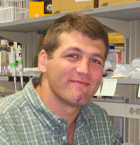
Project Title: Systems Genetics of Malaria Parasites
Project Primary Mentor: Michael Ferdig
Project Secondary Mentor: Scott Emrich, Nitesh Chwala, Holly Goodson.
Introduction:We use classical genetic inheritance studies, known as QTL mapping, to search for genes controlling drug resistance and virulence traits in a set of progeny malaria parasite clones. Using modern high-throughput genomic technologies to examine these same progeny, we generate gene interaction networks of transcripts, proteins and metabolites to identify the cellular and physiological signals of drug resistance. We can effectively map these complex regulatory and biochemical pathways on to classical traits to find drug resistance genes and to indentify vulnerablilites in the web of interactions that can be targeted by new antimalarial drugs.
Research Projects: listing two or more helps to show that students have choice, if you have any interdisciplinary projects, its best to list them.
- Linking gene expression regulatory networks to antimalarial drug susceptibility.
- Mechanisms of mutation and copy number variation in the malaria genome.
- Dissecting the gene interaction networks of growth, fitness and virulence in malaria parasites.
What the Student Will Learn: Student will learn the hypothesis-testing framework for quantitative genetics and systems biology. Student will learn basic biology of malaria parasites and its impact in context of global health.
Broader Impact: Because we use gene chips and sequencing to generate large datasets over several dimensions, we now team with computer scientists (Emrich, Chwala) to explore the whole system, known as systems biology. Also, we are interested in physical-chemical basis of drug-target interactions and will establish more relationships with biochemists to accomplish these goals (e.g., Goodson).

Simulating the Future Effects of Climate Change on Species.
Project Primary Mentor: Jessica Hellmann (ecology)
Project Secondary Mentors: Nitesh Chawla (computer acience) and Jason McLachlan (ecology)
Introduction: The geographic location of many species are strongly affected by climate and therefore are expected to change as climate shifts in the future. This shifting process will change the composition of communities and the way that ecosystems look and function. One of the challenges for conservation biology is predicting these future changes so that strategies can be designed to help species deal with this change and control other species that may become weedy or expand in undesirable ways. To make these predictions, we need to design tools that are easy to use and widely available, as well as biologically accurate.
Research Projects: To improve decision-making under climate change, we are working to improve projections for species changes under climate change, and we aim to make these tools available to land managers through the internet. We are building these improved projection tools using algorithms from computer science, including network theory and individual-based simulation modeling.
What the Student Will Learn: The student will learn about conservation biology by exploring the intersection of ecology and computer science, particularly network theory. To do this, the student will interact with mentors from two disciplines to build or improve upon existing models.
Broader Impact: This REU will help a student(s) learn advanced simulation skills that could be the basis for advanced study in computational biology. Computer-enabled projections are going to play an important role in the future of conservation biology, and the internet will grow as a place where intensive computation and data sharing takes place.
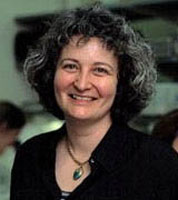
The Role of Genetic Differentiation in Speciation and Disease Ecology.
Primary Mentor: Hope Hollocher (molecular evolution)
Secondary Mentors: Agustin Fuentes (Anthropology) and Greg Madey (Computer Science)
Introduction: We study how genetic structuring of populations influences two different biological processes: speciation and pathogen transmission. With respect to speciation, my laboratory group is particularly fascinated by how changes in gene regulation and development govern morphological and reproductive divergence between closely related groups of organisms. We measure regulatory changes of single genes as well as at the level of the whole genome using microarray technology in order to understand how gene networks are built and shift during species formation. Our most recent research, in collaboration with Agustin Fuentes (Anthropology) and Greg Madey (Computer Science) incorporates evolutionary theory into the study of disease ecology. Here we use a multidisciplinary approach that incorporates population genetics, anthropology and computer modeling to investigate how physical landscape features and human land use practices shape genetic variation in host populations and influences the transmission and differentiation of pathogens.
Research Projects: Students are an integral part of all aspects of the research enterprise in our laboratory and matched up with different projects depending on their particular interests. All projects expose students to an arsenal of genetic and computational tools used to assay genetic variability across populations and to make inferences about population processes associated with speciation and pathogen transmission. We work on a variety of organisms, but primarily use different Drosophila species in Africa and the Caribbean to study genetic mechanisms underlying speciation and use long-tailed macaques from Southeast Asia to study pathogen transmission dynamics.
What the Student Will Learn: Students will have the opportunity to learn a variety of molecular techniques (e.g. DNA extraction, DNA amplification, cloning, and sequencing) as well as population genetic analyses used to interpret these molecular data either within the context of speciation or disease ecology. Depending on which aspect of the project is emphasized, students will also have the opportunity to gain experience in tissue preparation, antibody staining, microscopy, and computer modeling. Students are instructed on how to keep a laboratory notebook, troubleshoot, and design experiments to test specific hypotheses. Students are also encouraged to write-up their research and present their findings to a variety of different audiences, helping them to develop their communication skills on multiple levels.
Broader Impact: Students will broaden their perspectives about how evolution can be useful to answer a number of different questions of fundamental importance in biology. For example, understanding the genetic mechanisms underlying speciation has direct implications for conservation biology and maintaining biodiversity in a rapidly changing global landscape. In addition, by embedding evolutionary genetics into a larger multidisciplinary framework for understanding factors influencing pathogen transmission dynamics, students will gain an appreciation of how different disciplines, each with its own unique perspective, can work together to tease apart inherent complexities that are not reducible through one approach alone.
 Molecular Genetic Analysis of Zebrafish Eye Development and Retinal Regeneration.
Molecular Genetic Analysis of Zebrafish Eye Development and Retinal Regeneration.
Project Advisor: David R. Hyde
Introduction: My lab studies the mechanisms involved in eye development (both retina and lens) in zebrafish. Eye development proceeds very quickly, with a functional eye (based on behavior and electrophysiology) present within 72 hours after fertilization of the egg. Because the embryo develops external to the mother and the embryo is translucent, it is relatively straightforward to follow many of the developmental events using non-invasive microscopy. The advanced state of the zebrafish genome project, the ability to reduce the expression of embryonic genes using morpholinos and RNAi, and the panel of antibodies that my lab has generated, it is relatively straightforward to observe and perturb in precise ways the development of the functional eye. Using microarray experiments, we have identified a number of interesting genes that are candidates for being essential in lens and retinal development. We have also developed methods to kill specific neuronal populations in the retina and observe their regeneration. Microarray experiments have identified that a number of the genes differentially expressed in neuronal regeneration correspond to genes that are likely to be important in early retinal development.
Research Project: Regardless of the project that the student selects, the student and I will devise experiments that incorporate molecular and genetic techniques to examine one or two genes. This analysis may include cloning a candidate gene or promoter, DNA sequencing, in situ hybridization to examine the expression pattern of the candidate gene and morpholinos to knock-down the expression of the candidate protein. The student will then use a combination of histology, immunohistochemistry, and in situ hybridization to examine the effects that result from the loss of the candidate protein. We will then examine the potential role of the candidate protein in a biological process (such as eye development or retinal regeneration) by studying the process in wild-type and morpholino-injected embryos, which will again require histology, immunohistochemistry, and in situ hybridization. Thus, the student will gain an appreciation of the relationship between gene-protein-function-role in a biological process.
What the Student Will Learn: The student will be exposed to modern techniques in molecular genetics, including the generation and analysis of transgenic zebrafish, generation and analysis of transient mutants using RNAi and morpholinos, cloning of genes and analysis of their promoters, immunohistochemistry to examine cell-specific expression of proteins. They will be exposed to experimental design and the use of stringent controls, interpretation of data, and assembling the data into a presentation format (manuscripts or meeting posters). The students will also have the opportunity to see how their molecular genetic analysis relates to the physiological and cell biological studies that are being performed by graduate students and postdocs in the lab.
 Project Title: Role of complement in infectious disease
Project Title: Role of complement in infectious disease
Primary Mentor: Mary Ann McDowell
Secondary Mentor: Susanne Bohlson
Introduction: The overriding research interest of the laboratory is the immunobiology of infectious diseases. These infections account for more than 13 million deaths annually worldwide, being responsible for 1 in every 2 deaths in developing nations. Moreover, infectious diseases contribute substantially to slow economic and social progress in these countries. We primarily focus on the immunobiology of intracellular parasitism by studying one of the most intriguing intracellular parasite assemblages, Leishmania. Leishmania is an ideal research group to address immunoparasitological questions because it is amenable to modern technologies, has been extensively characterized, and is relevant as an important agent of human disease. The hallmark of an intracellular pathogen is its ability to survive within the intracellular niche. These organisms must be resistant to, or able to evade, the host cell’s microbicidal mechanisms. This dilemma is particularly relevant to Leishmania spp. because these organisms primarily reside within vertebrate macrophages (MPs), the main functions of which are to destroy foreign material and activate adaptive immunity. Leishmania do not actively invade host cells, but rely on the receptor-mediated phagocytic capacity of these cells to gain entry. Early studies suggested that L. major avoids activating MPs by entering the cell through phagocytic receptors that do not stimulate these cells. Examples of these “non-triggering” entry receptors are complement receptor 3 (CR3; Mac-1), FcReceptors (FcR), and mannose receptor (MR). Dr. Bohlson’s laboratory focuses on phagocyte recognition and clearance events of apoptotic cells an bacteria.
Research Projects: Students will have the opportunity to participate in one of three projects: 1) The role of complement and host cell receptors in inducing of inhibiting host cell signal transduction during infection with Leishmania parasites; 2) the role of pattern recognition receptors in phagocytosis; 3) the role of pattern recognition receptors in phagosome maturation.
What the Student Will Learn: Depending on the project students will learn a variety of immunological and cellular and molecular biological techniques. In addition, they will gain an appreciation for how different scientific disciplines can collaborate for discovering innovative solutions for controlling infectious diseases.

Project Title: Genetic Triggers of Retinal Degeneration
Project Primary Mentor: Joseph E. O’Tousa
Project Secondary Mentor: Dr. Kirk Mecklenburg, Indiana University South Bend
Introduction: Photoreceptor cells possess specialized cellular structures to allow efficient capture of light photons and the generation of the phototransduction response. These specializations are largely achieved through the expression of a set of photoreceptor specific genes. It is now clear that many of these genes are implicated in inherited retinal disease syndromes. In this project, the Drosophila model system will be used to investigate the cellular role of these genes.
Research Projects: The student will execute one or more of the following projects: 1) Create transgenic animals expressing engineered photoreceptor proteins tagged with green fluorescent protein. These will be used to examine the cellular location of the gene product during the degeneration process. 2) Study the influence of light conditions on the onset and severity of retinal degeneration. 3) Investigate genetic influences on the degeneration process by creating strains carrying the same mutation within different genetic backgrounds.
What the Student Will Learn: The student will understand the relationship between genetic defects and the biochemical and cellular processes affected by a mutant gene’s protein product. They will also understand the experimental advantage offered by models organisms to address genetic and molecular analyses of disease. They will see the rationale for, and insights to be gained from, comparative analysis of genomic information, and the experimental advantages afforded by model organisms. Increased life expectancies of human populations cause age-related and degenerative diseases to have a greater impact on human health. The project’s focus on genetics of retinal disease allows the student the opportunity to appreciate the value of using model organisms for fundamental “basic” research that may have novel biomedical implications.
Broader Impact: The collaboration with Dr. Kirk Mecklenburg allows the student to move easily between focused single gene analyses to the exploration of gene interactions at the genomic scale. The student will be able to make use of approaches of gene expression profiling, the analysis of a large set of retinal specific cDNA clones, and large-scale DNA sequencing efforts.
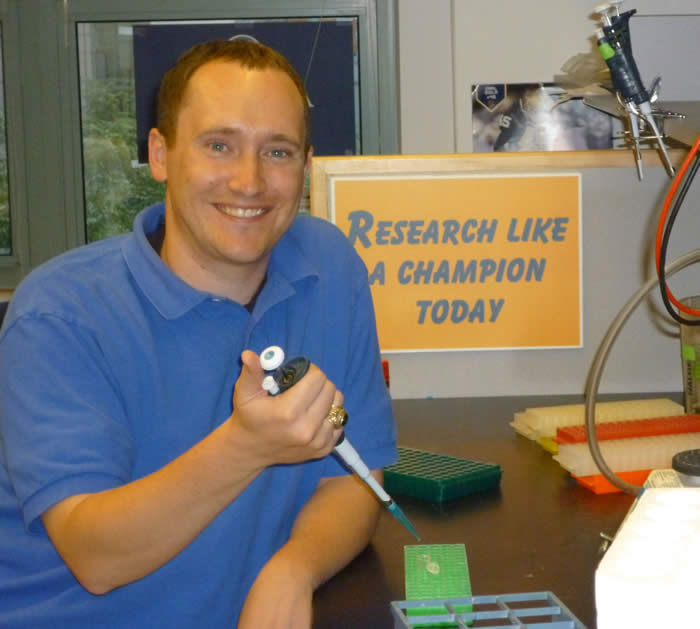 Identifying signaling pathways involved in ErbB2-mediated protection from detachment-induced cell death.
Identifying signaling pathways involved in ErbB2-mediated protection from detachment-induced cell death.
Project Primary Mentor: Zachary Schafer (cancer biology)
Project Secondary Mentor: Amanda Hummon (chemistry)
Introduction: It has recently been determined that mammary epithelial cells must inhibit classical cell death (apoptosis) and rectify metabolic defects in order to survive detachment from the extracellular matrix. However, oncogenes like ErbB2 will permit the survival of detached epithelial cells. ErbB2 affects numerous signaling pathways that regulate both apoptosis and metabolism, but it is not yet know which pathways are critical for the ability of ErbB2 to permit the survival of detached cells.
Research Projects: In order to address this question, a collaboration between my laboratory and the laboratory of Amanda B. Hummon in the Department of Chemistry and Biochemistry has been initiated. The Hummon laboratory has substantial expertise in RNAi based screening approaches and my laboratory is proficient in conducting cell biological approaches to understand cell death and metabolism. Thus, an siRNA based screen (using Qiagen siRNA libraries) of detached ErbB2 expressing mammary epithelial cells will be initiated in the Hummon lab to identify genes that are critical for the ErbB2 based rescue of apoptosis (caspase glo assay) and metabolism (ATP assay). Candidate genes will then be validated in the MCF-10A 3D cell culture assay and in soft agar transformation assays in my lab. We will be looking for candidate genes that may be involved solely in either the apoptotic regulation or the metabolic regulation and for “master regulators” that may affect both apoptosis and metabolism.
What the Student Will Learn: The student will learn a variety of cutting edge techniques in both my lab and in the Hummon lab. Working in the Hummon lab will expose students to techniques in global molecular profiling and will allow students to gain experience in acquiring and analyzing large quantities of data. Working in my lab will afford students the opportunity to learn the mammary 3D cell culture system and will allow them to become familiar with a wide variety of cell biology techniques.
Broader Impact: By undertaking this project, the student will be working on answering a critical question in cancer biology that has far reaching therapeutic implications. In addition, the chance to work in both a chemistry lab and a biology lab will expose the student to unique and complimentary approaches, methodology, and expertise and will give the student a much broader learning experience than could be obtained by working solely in my lab or the Hummon lab.
 Title: Knockdown of the Type VII secretion system in M. avium by siRNA
Title: Knockdown of the Type VII secretion system in M. avium by siRNA
Primary Mentor: Jeff Schorey
Secondary Mentor: Patty Champion
Introduction: For the past 11 years Dr. Schorey’s laboratory has been dissecting the M. avium components involved in virulence and has looked specifically at the interface between M. avium and its host cell the macrophage. Through studies by Dr. Champion and others using M. marinum and M. tuberculosis a new secretion system designated Type VII has been defined. In M. tuberculosis there are five Type VII secretion systems that appear to have arisen from gene duplication, some of which are essential for M. tuberculosis virulence. Comparative genomics as well as functional studies indicate that the Type VII secretion systems vary significantly between the different mycobacterial species and it is unclear if the pattern observed for M. tuberculosis will hold for M. avium and other non-tuberculosis related mycobacterial species.
Research Project: The student would be involved in using siRNA technology to knockdown an M. avium gene, which based on homology with a M. tuberculosis gene, would be expected to be involved in one of the Type VII secretion systems. The student would work with the mentors to define which would be the best gene(s) to target. Once the target gene is identified the student would design the siRNAs to synthesize, clone the siRNA into the proper cloning vector and transform the M. avium with the construct all under the guidance of the PIs and members of their laboratory. The gene knockdown will be confirmed and the phenotype of the mutant analyzed (i.e. define the protein secretion profile, assay for virulence in a macrophage infection model, etc.). The results obtained will be compared to what has been found for analogous studies in M. tuberculosis to determine how the different mycobacteria compare in their use of a particular Type VII secretion system.
What the Student Will Learn: The student will be exposed to a variety of techniques including cell culture of mycobacteria and macrophages, infection experiments, cloning and transformations as well as various protein-based analysis; Western blots, proteomics, ELISAs, etc. In addition, the student will learn about the powerful system of siRNA and how it can be used to manipulate protein expression.
Broader Impact: Dr Schorey brings experience in M. avium virulence as well as manipulation of gene expression in M. avium. Dr. Champion brings experience in the Type VII secretion systems in mycobacteria and how to measure changes in protein secretion and virulence upon blocking this secretion system. The student would certainly benefit from the related but distinct experience of the PIs.
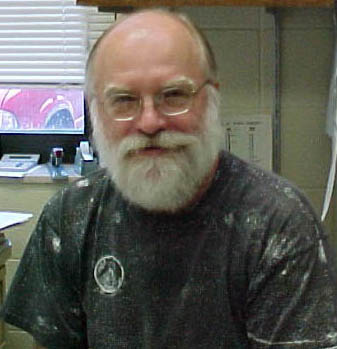 Molecular genetics of mosquito disease vectors.
Molecular genetics of mosquito disease vectors.
Project Primary Mentor: David Severson (genomics)
Project Secondary Mentor: Malcolm Fraser (virology)
Introduction: My lab employs genetic and genomics approaches to investigate the molecular basis for a variety of phenotypes observed in mosquito species. Our primary organism is the yellow fever and dengue virus vector mosquito Aedes aegypti. We have multiple projects involving this mosquito that include: 1) enhancing the status of the A. aegypti genome project; 2) investigating the molecular and cellular factors determining susceptibility to infection by dengue virus; 3) evaluating population genetics in disease endemic field sites that include Trinidad, Haiti, and India; and 4) examining the molecular biology of other important phenotypes such as autogeny, development, and meiotic drive. We are also investigating the molecular genetics of reproductive diapause in the West Nile virus vector mosquito Culex pipiens.
Research Project: Students will work with me to select a project that best suits their interests relative to research efforts we have ongoing at the time. For example, this may involve advanced characterization of individual genes, development and testing of constructs for gene silencing and subsequent phenotype evaluation, participation in whole transcriptome microarray analyses or NextGen sequencing efforts, or field population assays.
What the Student Will Learn: The student will employ the scientific method to further our understanding of some aspect of mosquito molecular genetics. This will include experimental design, hypothesis testing, data analysis, and data interpretation. In addition, the student will be exposed to a variety of contemporary molecular techniques as well as the opportunity to be involved in laboratory procedures for rearing large numbers of mosquitoes. The student will gain an appreciation and understanding of the relationship between molecular and whole organismal biology.
Broader Impact: Dr. Fraser and I share common interest in gaining better understanding of vector competence in mosquitoes, especially dengue virus transmission by A. aegypti. His expertise in insect transgenesis is a natural complement to my interests in molecular genetics. This collaboration will provide the student unique opportunities to explore molecular aspects of mosquito biology.
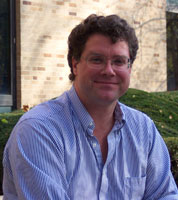
Project Title: Regulation of Organelle Transport.
Project Primary Mentor: Kevin T. Vaughan (cell biology)
Project Secondary Mentor: Holly V. Goodson (Chemistry and Biochemistry)
Introduction: The projects in the laboratory are centered on how molecular motors identify the correct cargo, and how motor function is regulated by phosphorylation. The motor protein we are focused on currently is the microtubule-based motor cytoplasmic dynein. This motor is responsible for many aspects of membrane transport and chromosome segregation during mitosis. We are working currently on several cytoplasmic dynein and dynactin subunits whose functions are regulated by phosphorylation. We are also working on how the dynactin complex functions as a dynein receptor on chromosomes and organelles. Recently, we mapped phosphorylation sites in the dynein motor that control dynein function in the spindle assembly checkpoint. Our lab integrates the use of conventional cell biology approaches (quantitative imaging, biochemistry, DNA cloning and mutant analysis and live cell analysis) with advanced proteomic methods (mass spectrometry), functional genomics (intelligent design chimeras) and kinomics (signal transduction complexity). These cutting edge approaches provide students with training in multi-dimensional dissection of complex and highly integrated systems.
Research Projects: Students will contribute to projects focused on mitotic regulation of the spindle assembly checkpoint, regulation of membrane transport by phosphorylation, or analysis of Niemann Pick Type C disease. Each project will include an interdisciplinary approach to a biochemical problem or disease model.
What the Student Will Learn: Students will learn experimental design, implementation of sophisticated cell biology techniques and advanced imaging techniques. Some projects include disease biopsy models and molecular biology associated with genetic analysis.
Broader Impact: Interdisciplinary aspects of the project include molecular modeling of protein structure and bioprobes for protein function. In addition, kinetic analysis of protein dynamics and regulation of dynamics by phosphorylation will include modeling techniques.
 Project Title: Regulation of Kidney Regeneration in the Zebrafish
Project Title: Regulation of Kidney Regeneration in the Zebrafish
Primary Mentor: Rebecca A. Wingert (Biology)
Secondary Mentor: Yongtao Zhang (Applied and Computational Mathematics & Statistics)
Introduction: The kidney is an essential organ that functions to cleanse the body of metabolic waste. The kidney is comprised of functional units known as nephrons, which are made of several specialized epithelial cell types that perform discrete roles in excretion and water balance. Recent studies have shown that damaged nephron cells in the adult kidney can be regenerated following injury from toxins or ischemia. Interestingly, several lines of evidence suggest that differentiated nephron epithelial cells fuel regeneration when they are induced to proliferate. However, there is a poor understanding of the cell and molecular changes involved in nephron regeneration, and conflicting data about the possible role of adult kidney stem cells in this process. We are seeking to understand how kidney regeneration occurs, and to identify the signaling pathways that can modulate kidney regeneration. We are utilizing an interdisciplinary approach to tackle these questions: we are modeling kidney regeneration in vivo, using the zebrafish, and using mathematical modeling to gain novel insights into regeneration mechanics.
Research Projects: Students will play a role in one or more of the following projects: 1. Gene expression analysis of kidney populations during regeneration; 2. Histological analysis of cellular changes during regeneration; 3. Real-time video microscopy of nephron regeneration; 4. Chemical genetic screening for small molecules that modulate cellular and/or gene expression changes during regeneration; 5. Mathematical analysis of regeneration events.
What the Student Will Learn: Students will participate in a vibrant laboratory community comprised of numerous graduate and undergraduate students. Students will learn experimental design, and hone their critical thinking skills by weekly participation in lab meetings and journal club discussions. At the bench, students will learn advanced cell biology and molecular biology techniques, as well as cutting edge microscopy. Students will have opportunities to implement statistical and mathematical modeling to better understand and make predictions about their data findings. Students will also have opportunities for independent and collaborative experimentation throughout the summer session, and thus be able to develop personal skills and forge active working relationships with other lab members. Finally, students will present their work in one or more poster sessions and be encouraged to participate in ongoing writing projects in the labs.
Broader Impact: The horizon of scientific investigation is changing: moving toward increased emphasis on collaborative ventures that join diverse expertise in order to truly understand the many facets of how nature works. Students involved in our kidney regeneration projects will experience the flavor of joining biological and mathematical approaches to understand how a vertebrate organ regenerates, and thus open their minds to the possibilities that can transpire when we harness diverse perspectives toward common goals.
 Project Title: Olfaction: Molecular, cellular and organismal approaches
Project Title: Olfaction: Molecular, cellular and organismal approaches
Project Primary Mentor: Zain Syed (Sensory Physiology and Behavior)
Project Secondary Mentor: Giles Duffield and Dave Severson
Overview: Insect have an exquisite olfactory system to detect and discriminate between hosts, habitats and mates. A male moth can locate a calling female from miles, and a mosquito can find its host from a long distance. Elaborate olfactory structures, called antenna (equivalent to human nose) endowed with many hair like structures called sensilla that house Olfactory Receptor Neurons (ORNs) that expressing a divergent family of Olfactory Receptors (ORs) to detect a variety of chemicals. We are interested in understanding the function and co-evolution of signals (volatile organic chemicals that act as ligands) and receivers/sensors (ORs) in a variety of insects, esp. mosquitoes and fruit flies. The work will involve genetic manipulation, electrophysiological recordings and behavioral observations.
Research Projects: There will be opportunity to undertake and/or contribute to a variety of projects this lab is interested in: 1- How the physiological properties of ORNs participate in encoding chemical landscape that insect live in 2- What are the key odorants that elicit robust olfactory behaviors, such as host and mate location and oviposition 3- How the developmental and experience-dependent plasticity in nervous systems is manifested at the cellular and molecular level and 4. How is repulsion mediated in insects?
What the Student Will Learn: A brief and focused training to search and manage scientific literature utilizing EndNote will be provided to help students get acquainted with the published work in their area of interest. Students will then be asked to formulate a hypothesis, design experiments and consult with PI/lab members on experimental execution. Students will participate in weekly group meetings with the PI and lab members to discuss the research and join the journal club. Towards the end of their program, students are expected to have developed scientific acumen and technical skills to carry out fairly independent investigations into cutting edge olfaction research.
Broader Impact: Insects are the most diverse and adaptable organisms on earth, representing more than half of all the known living organisms. They destroy or eat almost one third of our domesticated crops and produce. Others can transmit various life threatening diseases. We aim to exploit the extraordinary chemical communication system by identifying important ligands that can be used as attractant or repellents, especially for resource poor countries.
Department of Biological Sciences | University of Notre Dame Home | NSF Reu Official Site